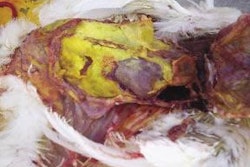Chinese government officials indicate that gaining access to the U.S. market for cooked poultry exports is a top priority. After all, food exports are an important part of China's economic growth. The country exported $2.5 billion of food ingredients to the USA and the rest of the world last year, up 150 percent from just two years earlier, according to Chinese industry estimates. The recent melamine contamination in Chinese feed ingredients, however, is causing customers and governments around the world to reevaluate the risks associated with China-sourced feed and food.
What investigations show about the Chinese suppliers is not reassuring. It appears that some producers of animal feed around China in order to boost profits have secretly supplemented their feed ingredients with melamine, a cheap additive that looks like protein in tests, but does not provide any nutritional benefits. Mislabeling was also involved. USDA reports that it was cheaper wheat flour not the wheat gluten and rice protein concentrate that customers thought they were buying behind the pet deaths and adulteration of animal feeds. Melamine contamination, alone, however, would not cause the kidney failure experienced in the pets that consumed products containing the contaminated ingredients. Some veterinarians in the United States suspect, in fact, that the deaths of the pets may have resulted from a combination of two different chemicals used to cheat buyers cyanuric acid and melamine. Apparently, cyanuric acid is another chemical believed to be commonly used by some Chinese suppliers to boost the protein readings of their animal feed ingredients.
Greed, allowed by lax laws and oversight in China, is what's behind this scandal. A small number of large manufacturers dominate the production of food ingredients in China, but scores of small, largely unknown producers operate without tough standards and enforcement. A reputable trader in food additives based in Shanghai has been quoted to say of this latter group, "Some of them are driven by profits; you can see dollar signs in their eyes."
With its huge global trade at stake, China stands to pay a price for the unsafe practices of some of its exporters. A number of U.S. suppliers, including Mission Foods and Tyson Foods, have already indicated they will not source ingredients from China.
But it appears that what the Chinese want in U.S. market access for their cooked poultry is more, not less. In 2005, USDA published a final rule to allow Chinese cooked poultry into the United States on the condition that these products use poultry meat from USDA slaughter plants. The Chinese authorities basically responded, No thanks,' to the proposal, seemingly bent instead on getting access in the U.S. market for Chinese grown and slaughtered poultry.
The USDA says its proposal to allow the sale of Chinese chicken is in the early stages. Under the plan, regulatory systems and plants must earn "equivalency" as being as safe as the U.S. system and its plants. "This is a process that has barely begun, and there is a very lengthy review," said Steven Cohen, a spokesperson for the USDA Food Safety and Inspection Service.
U.S. interests need to stay focused on two principles, which in the case of China seem to now be in competition. Those are a commitment to free trade and protecting the safety and integrity of the food supply. First, we need to stay committed to free trade including even for China if we expect to enjoy access to markets around the world. Second, our government must insure the equivalency of the food safety systems and products of any country importing poultry to the USA. Finally, U.S. producers should redouble their efforts to insure the integrity of their supply chains. Any problem regardless of the source with the safety of poultry products on the U.S. market is a problem for all U.S. producers.


















